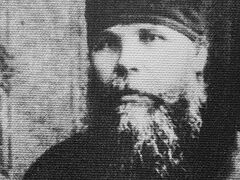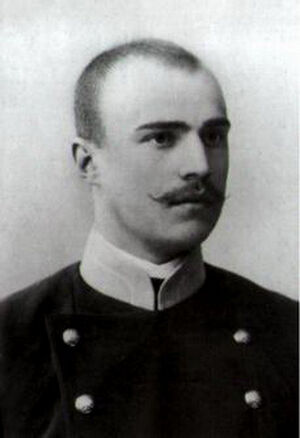 Count Yuri Alexandrovich Olsufiev On March 14 and 15, the Holy Trinity-St. Sergius Lavra prayerfully commemorates the servant of God George (Yuri), who was martyred in 1938, and his wife Sophia, whose life was cut short five years later in a Soviet labor camp. Their whole life was a true spiritual labor of salvaging the holy shrines of the Lavra, of sacrificial love for others, of confession of the faith, and finally, martyrdom. The Olsufievs and a group of like-minded people literally saved the vast majority of the priceless treasures and the most important buildings of the Lavra from destruction, and today we pay tribute to them with gratitude.
Count Yuri Alexandrovich Olsufiev On March 14 and 15, the Holy Trinity-St. Sergius Lavra prayerfully commemorates the servant of God George (Yuri), who was martyred in 1938, and his wife Sophia, whose life was cut short five years later in a Soviet labor camp. Their whole life was a true spiritual labor of salvaging the holy shrines of the Lavra, of sacrificial love for others, of confession of the faith, and finally, martyrdom. The Olsufievs and a group of like-minded people literally saved the vast majority of the priceless treasures and the most important buildings of the Lavra from destruction, and today we pay tribute to them with gratitude.
Count Yuri (George in Holy Baptism) Alexandrovich Olsufiev was a Russian art historian, restorer and museum worker; he was also a spiritual son of the Venerable Elder Anatoly (Potapov) the Younger of Optina (commemorated July 30/August 12). He graduated from the Department of Law at St. Petersburg University. In 1902, he married Sophia Vladimirovna Glebova and took up residence in the Buytsy family estate in the Tula province, where he was eagerly involved in charity activities, building an orphanage and a school. He carried on the work started by his father, heading the Committee for the Construction of the church in honor of St. Sergius of Radonezh on Kulikovo Field. The author of the design was the architect Alexei Viktorovich Shchusev (1873–1949). Sophia Vladimirovna Olsufieva, the count's wife, greatly contributed to the organization of a monastic community and sewing workshops at the church. She herself embroidered banners and a shroud for the church. A cross with a particle of the relics of St. Sergius of Radonezh was kept in the Olsufiev’s house, which was to be donated to the church. It was supposed that this shrine would make the church a destination for pilgrimages, but this never came to pass. The church was completed in 1917, after the Olsufievs had already moved to Sergiyev Posad. Soon afterwards, the monastic community at the church was dispersed.
Yuri Olsufiev made an archaeological collection with a description of the objects that peasants had found on Kulikovo Field.
“So he established a real museum, which had, for example, such treasures as a copper monastic cross found on Kulikovo Field. It is known from the chronicles that only two monks fought in the Russian Army: Alexander Peresvet and Rodion Oslyabya. Peresvet was killed in single combat with the Tatar champion Chelubey (Temir-Mirza). Therefore, the cross belonged to him... Sophia Vladimirovna was a very religious woman. When the Revolution broke out, St. Sergius of Radonezh appeared to her in a dream and told her to come and live near his shrine. She fulfilled his will,” recalls Prince Sergei Mikhailovich Golitsyn (1909–1989) in his Memoirs of a Survivor.
 Countess Sophia Vladimirovna Olsufieva (nee Glebova) and her family
Countess Sophia Vladimirovna Olsufieva (nee Glebova) and her family
The appearance of St. Sergius in a dream was not immediately perceived as a sign from above. The wife told her dream to Yuri Alexandrovich. They both decided that they should not hurry to do anything because dreams should not be trusted. But after the dream repeated three times, the couple went to Optina Monastery to ask St. Anatoly for advice, and he blessed them to move right away. Olsufiev’s presence at St. Sergius’s shrine played an exceptional role in preserving the Lavra's shrines and relics during that difficult time.
So, in the spring of 1917 Yuri Alexandrovich, his wife and son left the estate and bought a house on Valovaya Street in Sergiyev Posad [where the Lavra is located].
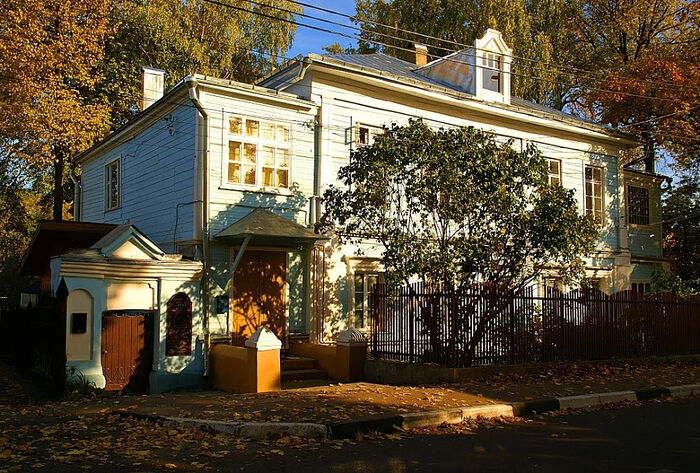 The Olsufievs’ house on Valovaya Street in Sergiyev Posad
The Olsufievs’ house on Valovaya Street in Sergiyev Posad
Count Olsufiev became an active member of the Commission for the Protection of Monuments of Art and Antiquities of the Holy Trinity-St. Sergius Lavra, then worked at the Sergiyev1 History and Art Museum (from 1918–1928). Here he courageously labored to save the Lavra shrines. Yuri Alexandrovich worked out a plan for the restoration of the architecture and paintings of the Holy Trinity Cathedral, was in charge of purchasing bricks for restoration work, restoring icons of the Holy Trinity Cathedral and bells of the Lavra bell tower, and examining icons of the sacristy and the churches and miniatures in the books of the Lavra library. He also worked with the archives of Archbishop Nikon (Rozhdestvensky) and solved many other issues.
When the plan became known of removing St. Sergius’ relics from the Lavra and their possible destruction, in March 1920, with the blessing of His Holiness Patriarch Tikhon, Count Olsufiev together with Fr. Pavel Florensky secretly hid St. Sergius’s holy skull.
Despite their difficult financial situation, the Olsufievs always tried to help others. They sheltered two noble families in their house on Valovaya Street: the Mansurovs and the Komarovskys. When the Russian religious philosopher and writer Vasily Vasilievich Rozanov became seriously ill, Sophia Vladimirovna helped him, was present at his death, and took all the arrangements for his funeral upon herself. In during the year 1939, Sophia Vladimirovna visited Rozanov’s seriously ill daughter in a Moscow hospital, and after eventually took her into her own home and cared for her. In the hungry 1920s, under the direction of Count Olsufiev, an agricultural cooperative was set up in Sergiyev Posad.
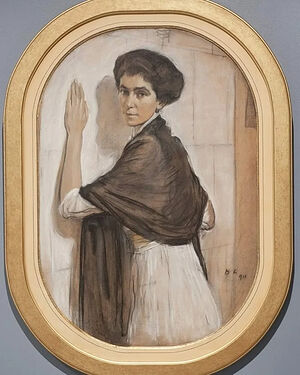 Portrait of Sophia Olsufieva by Valentin Serov (Pushkin State Museum of Fine Arts) In 1925, the local authorities attempted to initiate a legal case by arresting several “former nobles”. Olsufiev was charged at the same time with the following “crimes”: “He is of noble origin, had connections with counterrevolutionary monarchist elements, and conducted counterrevolutionary activities in order to overthrow the existing Soviet Government.” However, he was soon released due to lack of evidence.
Portrait of Sophia Olsufieva by Valentin Serov (Pushkin State Museum of Fine Arts) In 1925, the local authorities attempted to initiate a legal case by arresting several “former nobles”. Olsufiev was charged at the same time with the following “crimes”: “He is of noble origin, had connections with counterrevolutionary monarchist elements, and conducted counterrevolutionary activities in order to overthrow the existing Soviet Government.” However, he was soon released due to lack of evidence.
In the spring of 1928, a slander campaign against the “former nobles” who lived in Sergiyev Posad began in the central and local press—specially against Priest Pavel Florensky and Count Yuri Alexandrovich Olsufiev, the co-authors of the book, “Ambrose, the Trinity Wood-Carver of the Fifteenth Century”, which was published in 1927 and provoked fierce criticism of its authors in the press. Olsufiev then managed to leave town, avoiding arrest. He lived with his wife Sophia Vladimirovna near Moscow, worked at the Central Restoration Workshops, and then at the State Tretyakov Gallery. Salvaging works of ancient Russian painting—icons and frescoes, Yuri Alexandrovich traveled the length and breadth of central Russia, all over the North, the Novgorod and Pskov regions. His spouse accompanied her husband everywhere. There is no doubt that the Olsufievs lived in order to keep the hidden skull of St. Sergius and save the shrines that could still be saved.
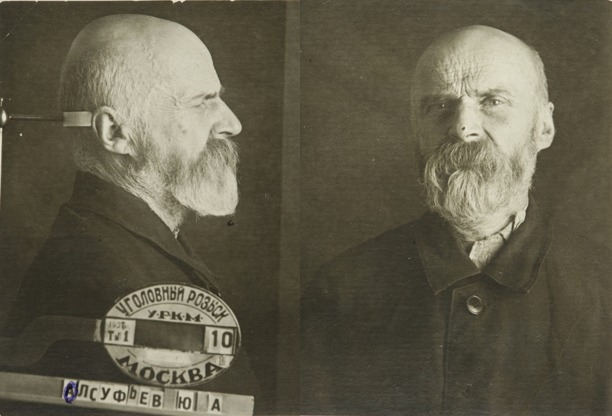 Yuri A. Olsufiev. Photos from the investigative case
Yuri A. Olsufiev. Photos from the investigative case
Yuri Alexandrovich Olsufiev was arrested in January 1938 and charged under Article 58-10, “Spreading anti-Soviet rumors”. He was executed by a firing squad at the Butovo firing range near Moscow. His wife Sophia Vladimirovna Olsufieva was arrested on November 1, 1941, when the authorities decided that the surviving aristocrats were allegedly waiting for the Nazis. She was sentenced to ten years in prison and sent to the Sviyazhsk correctional labor colony (on the site of the former Sviyazhsk Dormition Monastery in Tatarstan), where she died on March 15, 1943—five years and one day after her husband.


